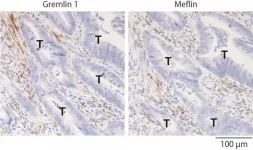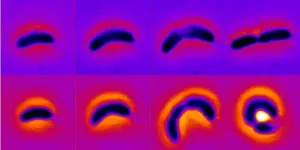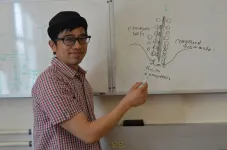Study finds potential therapeutic targets to inhibit colorectal cancer progression
2021-01-30
(Press-News.org) Nagoya University researchers and colleagues have revealed that colorectal cancer tissues contain at least two types of fibroblasts (a type of cells found in connective tissue), namely, cancer-promoting fibroblasts and cancer-restraining fibroblasts, and that the balance between them is largely involved in the progression of colorectal cancer. Their findings, recently published in the journal Gastroenterology, suggest that artificially altering the balance between the two types of cells could curb the spread of colorectal cancer tumors, which may become an effective strategy for preventing cancer progression.
Cancer tissues comprise both cancer cells and non-malignant cells such as fibroblasts. Previous studies have suggested that the proliferation of fibroblasts is largely involved in the progression of colorectal cancer, the most common cancer in Japan. Fibroblasts within cancer tissues, called cancer-associated fibroblasts (CAFs), are considered to be divided into at least two populations: those that promote cancer progression and those that restrain it. Impeding the function of cancer-promoting CAFs could be a promising method to prevent cancer progression, but a lack of understanding of the mechanism underlying heterogeneity of CAFs has hampered its development.
In normal colon tissues, proteins called bone morphogenetic proteins (BMPs), which are secreted by stromal cells, are known to play a critical role in regulating intestinal homeostasis, whereas in cancerous colon tissues, they are considered to be associated with cancer progression. In this context, the research team led by Professors Atsushi Enomoto and Masahide Takahashi of the Graduate School of Medicine at Nagoya University in Japan conducted a study to determine how stroma cells lead BMPs to be involved in the progression of colorectal cancer.
The team first analyzed comprehensive gene expression profiling data to identify BMP-related genes that are specifically expressed in colorectal CAFs. Two types of proteins, meflin and gremlin 1, were identified to be encoded by such genes. Next, to investigate the relevance of these proteins in colorectal cancer progression, Prof. Enomoto and his colleagues, who had previously shown that meflin plays a role in restraining the progression of pancreatic cancer, conducted a study in collaboration with researchers from the University of Adelaide and the South Australian Health and Medical Research Institute, who have conducted studies focusing on the role of gremlin 1 as a BMP inhibitor in the intestine.
The joint research group examined the prognostic significance of the expression of meflin and gremlin 1 in colorectal cancer patients and found that, interestingly, those with a high expression of meflin have a favorable prognosis, whereas those with a high expression of gremlin 1 have an unfavorable prognosis. In addition, experiments using a mouse model revealed that the proliferation of colorectal cancer cells can be suppressed through administration of a gremlin 1-neutralizing antibody or overexpression of meflin.
Regarding the role of BMP signaling mediated by stromal gremlin 1 and meflin in colorectal cancer, Prof. Enomoto explains, "We hypothesize that CAFs mediated by gremlin 1 promote cancer progression by decreasing BMP signaling, whereas CAFs mediated by meflin restrain the growth of the cancer by reinforcing BMP signaling." Therefore, intensifying stromal BMP signaling, either by using a gremlin 1-neutralizing antibody or by overexpressing meflin, could be an attractive therapeutic strategy to treat colorectal cancer.
INFORMATION:
The study, "The balance of stromal BMP signaling mediated by GREM1 and ISLR drives colorectal carcinogenesis," was published online in the journal Gastroenterology on November 14, 2020 at DOI 10.1053/j.gastro.2020.11.011.
About Nagoya University, Japan
Nagoya University has a history of about 150 years, with its roots in a temporary medical school and hospital established in 1871, and was formally instituted as the last Imperial University of Japan in 1939. Although modest in size compared to the largest universities in Japan, Nagoya University has been pursuing excellence since its founding. Six of the 18 Japanese Nobel Prize-winners since 2000 did all or part of their Nobel Prize-winning work at Nagoya University: four in Physics - Toshihide Maskawa and Makoto Kobayashi in 2008, and Isamu Akasaki and Hiroshi Amano in 2014; and two in Chemistry - Ryoji Noyori in 2001 and Osamu Shimomura in 2008. In mathematics, Shigefumi Mori did his Fields Medal-winning work at the University. A number of other important discoveries have also been made at the University, including the Okazaki DNA Fragments by Reiji and Tsuneko Okazaki in the 1960s; and depletion forces by Sho Asakura and Fumio Oosawa in 1954.
Website: http://en.nagoya-u.ac.jp/
[Attachments] See images for this press release:

ELSE PRESS RELEASES FROM THIS DATE:
2021-01-30
(Singapore--January 29, 2021 9:35 a.m. SPT/January 28, 2021 8:35 p.m. EST)--Two radiation oncology trials presented at the IALSC World Conference on Lung Cancer Singapore highlight how some researchers are exploring use of higher radiation boost doses to only PET-positive regions in locally-advanced non-small cell lung cancer (NSCLC). A previous large RTOG phase III trial revealed that the unform delivery of a high dose to the entire tumor led to poorer survival.
In one study, Prof. Feng-Ming (Spring) Kong, Case Western Reserve University School of Medicine, in Cleveland, Ohio presented the results of a multicenter trial which aimed to ...
2021-01-30
(Singapore Embargoed for 7:23pm EST on January 29, 2021 to coincide with publication in the Journal of Clinical Oncology) -- Adding ipilimumab to pembrolizumab does not improve efficacy and is associated with greater toxicity than pembrolizumab alone as first-line therapy for metastatic non-small cell lung cancer (NSCLC) for patients with a PD-L1 tumor proportion score of greater than or equal to 50% and no targetable EGFR or ALK aberrations, according to research presented today at the International Association for the Study of Lung Cancer's World Conference on Lung Cancer.
The research was presented ...
2021-01-29
New research led by Carnegie Mellon University Assistant Professor of Physics Shiladitya Banerjee demonstrates how certain types of bacteria can adapt to long-term exposure to antibiotics by changing their shape. The work was published this month in the journal Nature Physics.
Adaptation is a fundamental biological process driving organisms to change their traits and behavior to better fit their environment, whether it be the famed diversity of finches observed by pioneering biologist Charles Darwin or the many varieties of bacteria that humans coexist with. While antibiotics have long helped people prevent and cure bacterial infections, many species of bacteria have increasingly been able to adapt to ...
2021-01-29
School closures during COVID-19 have decreased access to school meals, which is likely to increase the risk for food insecurity among children in Maryland, according to a new report issued by researchers at the University of Maryland School of Medicine (UMSOM). The number of meals served to school-age children during the first three months of the pandemic dropped by 58 percent, compared to the number of free or reduced-price meals served the previous spring. As a result, thousands of children across the state were placed at increased risk of food insecurity, with many likely experiencing the health ramifications ...
2021-01-29
Boulder, Colo., USA: GSA's dynamic online journal, Geosphere, posts articles online regularly. Topics for articles posted for Geosphere this month include feldspar recycling in Yosemite National Park; the Ragged Mountain Fault, Alaska; the Khao Khwang Fold and Thrust Belt, Thailand; the northern Sierra Nevada; and the Queen Charlotte Fault.
Feldspar recycling across magma mush bodies during the voluminous Half Dome and Cathedral Peak stages of the Tuolumne intrusive complex, Yosemite National Park, California, USA
Louis F. Oppenheim; Valbone Memeti; Calvin G. Barnes; Melissa Chambers; Joachim Krause ...
Abstract: Incremental pluton growth can produce sheeted complexes with no magma-magma interaction or large, dynamic magma bodies communicating via crystal and melt exchanges, depending ...
2021-01-29
Washington, DC — Blood pressure that remains elevated over of time — known as chronic hypertension — has been linked to heart disease, which is the leading cause of death in the United States. Recent research has shown that persistent high blood pressure may also increase the risk for stroke and overall mortality. Yet, only about 1 in 4 adults with chronic hypertension have their condition under control, according to the Centers for Disease Control and Prevention.
In a new study to be presented today at the Society for Maternal-Fetal Medicine's (SMFM) annual meeting, The Pregnancy Meeting™, researchers from the University of Pittsburgh will unveil findings that suggest that women who develop high blood pressure during pregnancy and who continue ...
2021-01-29
News reports indicate COVID-19 vaccines are not getting out soon enough nor in adequate supplies to most regions, but there may be a larger underlying problem than shortages. A University of California, Davis, study found that more than a third of people nationwide are either unlikely or at least hesitant to get a COVID-19 vaccine when it becomes available to them.
The results are from public polling of more than 800 English-speaking adults nationwide in a study published online earlier this month in the journal Vaccine.
"Our research indicates that vaccine uptake will be suboptimal ... with 14.8 percent of respondents being unlikely to get vaccinated ...
2021-01-29
WOODS HOLE, Mass. -- The most powerful substance in the human brain for neuronal communication is glutamate. It is by far the most abundant, and it's implicated in all kinds of operations. Among the most amazing is the slow restructuring of neural networks due to learning and memory acquisition, a process called synaptic plasticity. Glutamate is also of deep clinical interest: After stroke or brain injury and in neurodegenerative disease, glutamate can accumulate to toxic levels outside of neurons and damage or kill them.
Shigeki Watanabe of Johns Hopkins University School of Medicine, a familiar face at the Marine Biological Laboratory (MBL) as a faculty member and researcher, is hot on the ...
2021-01-29
RIVERSIDE, Calif. -- When we step on the car brake upon seeing a red traffic light ahead, a sequence of events unfolds in the brain at lightning speed.
The image of the traffic light is transferred from our eyes to the visual cortex, which, in turn, communicates to the premotor cortex -- a section of the brain involved in preparing and executing limb movements. A signal is then sent to our foot to step on the brake. However, brain region that helps the body go from "seeing" to "stepping" is still a mystery, frustrating neuroscientists and psychologists.
To unpack this "black box," a team of neuroscientists at the University of California, Riverside, has ...
2021-01-29
A new report combining forecasting and expert prediction data, predicts that 125,000 lives could be saved by the end of 2021 if 50% or more of the U.S. population initiated COVID vaccination by March 1, 2021.
"Meta and consensus forecast of COVID-19 targets," developed by Thomas McAndrew, a computational scientist and faculty member at Lehigh University's College of Health, and colleagues, incorporates data from experts and trained forecasters, combining their predictions into a single consensus forecast. In addition McAndrew and his team produce a metaforecast, which is a combination of an ensemble of computational models and their consensus forecast.
In addition to predictions related to the impact of vaccinations, ...
LAST 30 PRESS RELEASES:
[Press-News.org] Study finds potential therapeutic targets to inhibit colorectal cancer progression




